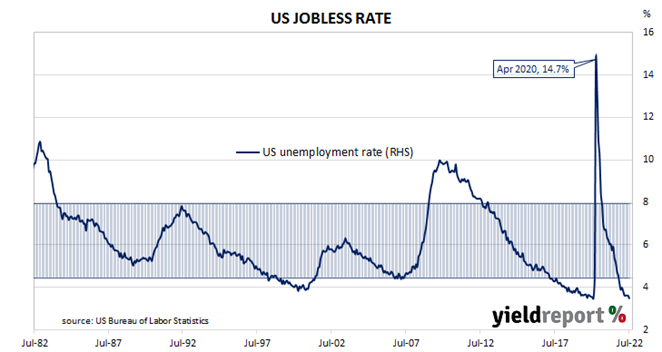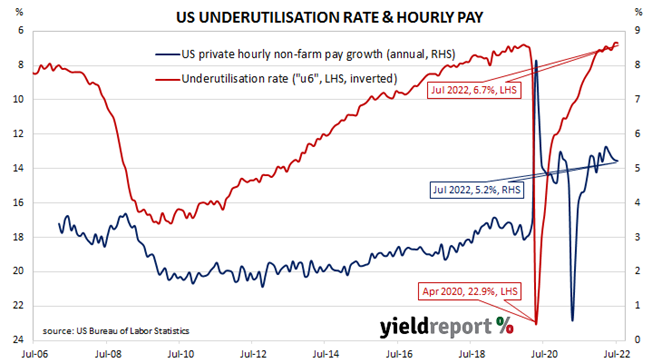Summary: Non-farm payrolls up by 528,000 in July, double expected rise; previous two months’ figures revised up by 28,000; jobless rate steady declines to 3.5%, participation rate slips to 62.1%; services lead charge, construction, manufacturing also strong; jobs-to-population ratio ticks up to 60.0%; underutilisation rate steady at 6.7%; annual hourly pay growth steady at 5.2%.
The US economy ceased producing jobs in net terms as infection controls began to be implemented in March 2020. The unemployment rate had been around 3.5% but that changed as job losses began to surge through March and April of 2020. The May 2020 non-farm employment report represented a turning point and subsequent months provided substantial employment gains. Changes in recent months have been generally more modest but also well above the long-term monthly average.
According to the US Bureau of Labor Statistics, the US economy created an additional 528,000 jobs in the non-farm sector in July. The increase was more than double the 250,000 which had been generally expected but considerably more than the 398,000 jobs which had been added in June after revisions. Employment figures for May and June were revised up by a total of 28,000.
The total number of unemployed decreased by 242,000 to 5.670 million while the total number of people who are either employed or looking for work decreased by 63,000 to 163.960 million. These changes led to the US unemployment rate declining from 3.6% to 3.5%. The participation rate assisted by slipping from June’s rate of 62.2% to 62.1%. “Services led the charge but construction and manufacturing were also strong, belying recent indicators,” said ANZ Rates Strategist Gregorius Steven. “Noise in the seasonal adjustment factor could feed into downward surprises in coming months; all else equal but there’s no question that the US labour market is extremely tight.”
US Treasury yields jumped on the day. By the close of business, the 2-year yield had gained 19bps to 3.21%, the 10-year yield had added 17bps to 2.83% while the 30-year yield finished 12bps higher at 3.07%.
In terms of US Fed policy, expectations of a steeper path for the federal funds rate over the next 12 months hardened. At the close of business, September contracts implied an effective federal funds rate of 2.555%, 23bps higher than the current spot rate, while November contracts implied 3.36%. July 2023 futures contracts implied an effective federal funds rate of 3.475%, 115bps above the spot rate.
One figure which is indicative of the “spare capacity” of the US employment market is the employment-to-population ratio. This ratio is simply the number of people in work divided by the total US population. It hit a cyclical-low of 58.2 in October 2010 before slowly recovering to just above 61% in late-2019. July’s reading ticked up from 59.9 to 60.0%, still some way from the April 2000 peak reading of 64.7%.
Wage growth spiked in the US during the early stages of pandemic restrictions as lower-paid jobs disappeared at a faster rate relative to higher-paid jobs, disrupting the usual relationship between wage inflation and unemployment rates. Normally, wages tend to grow as the supply of labour tightens.
Apart from the unemployment rate, another measure of tightness in the labour market is the underutilisation rate and the latest reading of it remained steady at 6.7%. Wage inflation and the underutilisation rate usually have an inverse relationship and hourly pay growth in the year to July remained unchanged from June’s revised rate of 5.2%.



